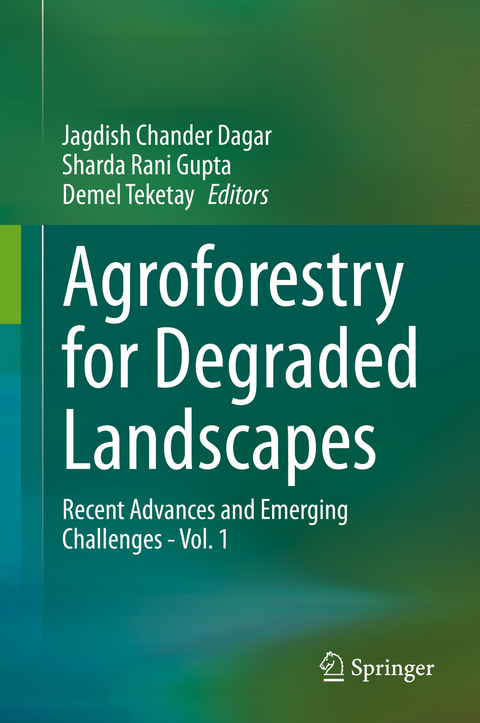
Agroforestry for Degraded Landscapes
Springer Verlag, Singapore
978-981-15-4135-3 (ISBN)
Jagdish Chander Dagar, Former Assistant Director General and Emeritus Scientist at ICAR, has long been actively involved in the areas of agroforestry, natural resources management, biosaline agriculture, rehabilitation of degraded lands, ethnobotany, plant ecology, environmental sciences, biodiversity, climate change and sustainable agriculture, as can be seen in his more than 300 research papers, published in peer-reviewed journals, book chapters and conference proceedings. He has been conferred with several awards and honours and is a Fellow of the National Academy of Agricultural Sciences and several other professional societies. He has also been a consultant to the UN, CIMMYT, and Haryana Forest Department. Dr Dagar is also Chief Editor of the Journal Soil Salinity & Water Quality. S. R. Gupta, former Professor of Botany, Dean of Life Sciences, and Emeritus Fellow of the UGC, is a nationally and internationally recognised ecologist who has taught at the Department of Botany and at the Institute of Environmental Studies at Kurukshetra University, India. She has made significant contributions to better understanding the biodiversity and ecosystem functions of grasslands, forest ecosystems, soil biodiversity, ecological rehabilitation of salt-affected soils, carbon sequestration in agroforestry systems, and the sustainability of conservation agricultural systems. The author of 98 research papers published in national and international journals, she is also a Fellow of the National Institute of Ecology and is affiliated with the Institute of Environmental Studies. Demel Teketay Fanta received his MSc in Plant Taxonomy from Reading University (UK) and PhD in Forest Vegetation Ecology from the Swedish University of Agricultural Sciences. He is currently serving as a Professor of Forest Sciences and founding Dean of the Faculty of Natural Resources at Botswana University of Agriculture and Natural Resources (BUAN). He has published over 250 scientific articles and technical reports, including more than 150 peer-reviewed articles in national and international scientific journals. He is a Fellow of The World Academy of Sciences (TWAS), International Fellow of the Royal Swedish Academy of Agriculture and Forestry (KSLA), Fellow of the African Academy of Sciences (AAS), Associate Fellow of the Ethiopian Academy of Sciences (EAS), and a Member of the Botswana Academy of Science (BAS).
Chapter 1. Introduction.- Chapter 2. Agroforestry for Rehabilitation of Degraded Landscapes: Achieving Livelihood and Environmental Security.- Chapter 3. Agroforestry to Enhance Livelihood Security in Africa: Research Trends and Emerging Challenges.- Chapter 4. Potential of Agroforestry to Enhance Livelihood Security in Africa.- Chapter 5. Agroforestry Systems for Arid Ecologies in India.- Chapter 6. Land Use Management by Small Holders’ Households as a Promising Way for Synergies Between the Rio Conventions: Case Study in Semi-arid Areas of Cameroon.- Chapter 7. Impacts of Climate Change on Ecosystem Services of Agroforestry Systems in the West African Sahel: A Review.- Chapter 8. Agroforestry Systems for Improving Nutrient Recycling and Soil Fertility on Degraded Lands.- Chapter 9. Sustainability of Faidherbia albida-based Agroforestry in Crop Production and Maintaining Soil Health.- Chapter 10. Characterization of Faidherbia albida and Prosopis africana Trees Wood Anatomy and Response to Climate Variability Using Dendrochronology in the Sahelian Agroforestry Parklands.- Chapter 11. Potential of Gliricidia-based Agroforestry Systems for Resource Limited Agro-ecosystems.- Chapter 12. Lac-based Agroforestry System for Degraded Land.- Chapter 13. The Role of Insects in Enhancing Ecosystem Services of Tree-based Systems on Degraded Lands.- Chapter 14. Socio-economic and Policy Issues in Relation to Adoption of Agroforestry in Africa.- Chapter 15. Agroforestry Options for Degraded Landscapes in Southeast Asia.- Chapter 16. Community-based Peat Swamp Restoration through Agroforestry in Indonesia.- Chapter 17. Agroforestry to Sustain Island and Coastal Agriculture in Scenario of Climate Change: Indian Perspective.- Chapter 18. Incentivizing Hill Farmers for Promoting Agroforestry as an Alternative to Shifting Cultivation in North-East India.- Chapter 19. Promoting Bamboo-based Agroforestry for Enhancing Ecosystem Services from Degraded Lands.- Chapter 20. The Contribution of Agroforestry to Restoration and Conservation: Biodiversity Islands in Degraded Landscapes.- Chapter 21. Soil Micro-arthropods as Indicators of Soil Health of Tropical Homegardens in Kerala, India.- Chapter 22. Biomass Production Potentials under Temperate Agroforestry Systems as Influenced by Selected Sustainability Indicators: A Case Study Approach with Supportive Evidence.- Chapter 23. Management Practices vis-a-vis Agroforestry for the Improvement of Rangelands of Jammu and Kashmir in Northwestern Himalaya.- Chapter 24. The influence of Over-mature, Degraded Nothofagus Forests with Strong Anthropic Disturbance on the Quality of an Andisol, and Its Gradual Recovery with Silvopasture in Southwestern South America.- Chapter 25. Assessment of Trees Outside Forests (TOF) with emphasis on agroforestry systems.- Chapter 26. Agroforestry Interventions for Rehabilitating Salt-affected and Waterlogged Marginal Landscapes.- Chapter 27. Silvopasture Options for Enhanced Biological Productivity of Degraded Pasture/Grazing Lands: An Overview.- Chapter 28. Potential of Agroforestry for Rehabilitation of Degraded Ravine Lands.- Chapter 29. Halophytes for Utilizing and Restoring Coastal Saline Soils of India: Emphasis on Agroforestry Mode.- Chapter 30. Urban and Peri-urban Agroforestry: Utilization of Waste Water and Degraded Landscapes for Environmental and Livelihood Security.- Chapter 31. Agroforestry Approach for Rehabilitation of Mine Spoils.- Chapter 32. Tree Plantations for Improving Soil Fertility and Carbon Sequestration on Mine Spoils.- Chapter 33. Carbon Sequestration Potential of Agroforestry Systems for Rehabilitating Degraded Lands of India.- Chapter 34. Agroforestry Developments for Degraded Landscapes: A Synthesis.
| Erscheinungsdatum | 09.10.2020 |
|---|---|
| Zusatzinfo | 88 Illustrations, color; 15 Illustrations, black and white; XVII, 554 p. 103 illus., 88 illus. in color. |
| Verlagsort | Singapore |
| Sprache | englisch |
| Maße | 155 x 235 mm |
| Themenwelt | Naturwissenschaften ► Biologie ► Botanik |
| Naturwissenschaften ► Biologie ► Ökologie / Naturschutz | |
| Weitere Fachgebiete ► Land- / Forstwirtschaft / Fischerei | |
| ISBN-10 | 981-15-4135-3 / 9811541353 |
| ISBN-13 | 978-981-15-4135-3 / 9789811541353 |
| Zustand | Neuware |
| Haben Sie eine Frage zum Produkt? |
aus dem Bereich


